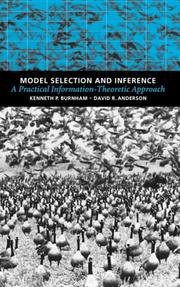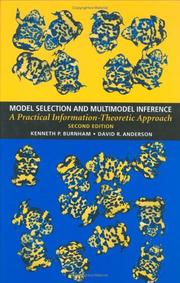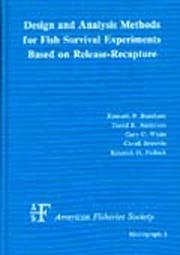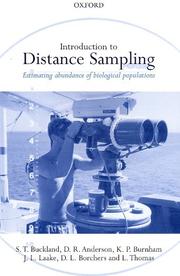| Listing 1 - 8 of 8 |
Sort by
|
Book
Year: 1980 Publisher: Washington The Wildlife Society
Abstract | Keywords | Export | Availability | Bookmark
 Loading...
Loading...Choose an application
- Reference Manager
- EndNote
- RefWorks (Direct export to RefWorks)

ISBN: 0387985042 1475729197 1475729170 9780387985046 Year: 1998 Publisher: New York: Springer,
Abstract | Keywords | Export | Availability | Bookmark
 Loading...
Loading...Choose an application
- Reference Manager
- EndNote
- RefWorks (Direct export to RefWorks)
We wrote this book to introduce graduate students and research workers in var ious scientific disciplines to the use of information-theoretic approaches in the analysis of empirical data. In its fully developed form, the information-theoretic approach allows inference based on more than one model (including estimates of unconditional precision); in its initial form, it is useful in selecting a "best" model and ranking the remaining models. We believe that often the critical issue in data analysis is the selection of a good approximating model that best represents the inference supported by the data (an estimated "best approximating model"). In formation theory includes the well-known Kullback-Leibler "distance" between two models (actually, probability distributions), and this represents a fundamental quantity in science. In 1973, Hirotugu Akaike derived an estimator of the (relative) Kullback-Leibler distance based on Fisher's maximized log-likelihood. His mea sure, now called Akaike 's information criterion (AIC), provided a new paradigm for model selection in the analysis of empirical data. His approach, with a funda mental link to information theory, is relatively simple and easy to use in practice, but little taught in statistics classes and far less understood in the applied sciences than should be the case. We do not accept the notion that there is a simple, "true model" in the biological sciences.
Mathematical statistics --- 519.226 --- 519.72 --- Inference and decision theory. Likelihood. Bayesian theory. Fiducial probability --- Information theory: mathematical aspects --- Biology --- Mathematical statistics. --- Mathematical models. --- 519.72 Information theory: mathematical aspects --- 519.226 Inference and decision theory. Likelihood. Bayesian theory. Fiducial probability --- Mathematics --- Statistical inference --- Statistics, Mathematical --- Statistics --- Probabilities --- Sampling (Statistics) --- Biological models --- Biomathematics --- Mathematical models --- Statistical methods --- Statistics . --- Statistical Theory and Methods. --- Statistical analysis --- Statistical data --- Statistical science --- Econometrics --- Biology. --- Life sciences --- Life (Biology) --- Natural history --- Biology - Mathematical models

ISBN: 0387953647 9786610009480 1280009489 0387224564 9780387953649 Year: 2002 Publisher: New York, N.Y. Springer
Abstract | Keywords | Export | Availability | Bookmark
 Loading...
Loading...Choose an application
- Reference Manager
- EndNote
- RefWorks (Direct export to RefWorks)
We wrote this book to introduce graduate students and research workers in various scienti?c disciplines to the use of information-theoretic approaches in the analysis of empirical data. These methods allow the data-based selection of a “best” model and a ranking and weighting of the remaining models in a pre-de?ned set. Traditional statistical inference can then be based on this selected best model. However, we now emphasize that information-theoretic approaches allow formal inference to be based on more than one model (m- timodel inference). Such procedures lead to more robust inferences in many cases, and we advocate these approaches throughout the book. The second edition was prepared with three goals in mind. First, we have tried to improve the presentation of the material. Boxes now highlight ess- tial expressions and points. Some reorganization has been done to improve the ?ow of concepts, and a new chapter has been added. Chapters 2 and 4 have been streamlined in view of the detailed theory provided in Chapter 7. S- ond, concepts related to making formal inferences from more than one model (multimodel inference) have been emphasized throughout the book, but p- ticularly in Chapters 4, 5, and 6. Third, new technical material has been added to Chapters 5 and 6. Well over 100 new references to the technical literature are given. These changes result primarily from our experiences while giving several seminars, workshops, and graduate courses on material in the ?rst e- tion.
Biology --- Mathematical statistics. --- Mathematical models. --- Biomathematics. Biometry. Biostatistics --- Mathematical statistics --- -#SBIB:303H61 --- 519.72 --- 519.72 Information theory: mathematical aspects --- Information theory: mathematical aspects --- Mathematics --- Statistical inference --- Statistics, Mathematical --- Statistics --- Probabilities --- Sampling (Statistics) --- Life sciences --- Biomass --- Life (Biology) --- Natural history --- Mathematical models --- Wiskundige methoden en technieken --- Statistical methods --- Biologie --- Statistique mathématique --- Modèles mathématiques --- EPUB-LIV-FT SPRINGER-B --- Statistics. --- Ecology. --- Statistical Theory and Methods. --- Statistics for Life Sciences, Medicine, Health Sciences. --- #SBIB:303H61 --- Biological models --- Biomathematics --- Statistics . --- Ecology . --- Balance of nature --- Bionomics --- Ecological processes --- Ecological science --- Ecological sciences --- Environment --- Environmental biology --- Oecology --- Environmental sciences --- Population biology --- Statistical analysis --- Statistical data --- Statistical science --- Econometrics --- Ecology --- Biology - Mathematical models.
Book
ISBN: 0412426609 0412426706 9401115745 9780412426704 9780412426605 Year: 1993 Publisher: London : Chapman and Hall,
Abstract | Keywords | Export | Availability | Bookmark
 Loading...
Loading...Choose an application
- Reference Manager
- EndNote
- RefWorks (Direct export to RefWorks)
Biomathematics. Biometry. Biostatistics --- General ecology and biosociology --- Animal populations --- Sampling (Statistics) --- Estimates. --- MET Methods & Techniques --- abundance --- animal populations --- estimation --- mathematical methods --- population --- sampling --- statistical methods --- statistics --- Sampling (Statistics). --- plant population --- Animal population --- Sampling --- Statistical methods --- Population distribution --- population density --- Models --- Évaluation --- evaluation --- evaluation. --- Animal populations - Estimates

ISBN: 0913235415 Year: 1987 Publisher: Bethesda American fisheries society
Abstract | Keywords | Export | Availability | Bookmark
 Loading...
Loading...Choose an application
- Reference Manager
- EndNote
- RefWorks (Direct export to RefWorks)
Fishes --- -Hydroelectric power plants --- -Fisheries --- -Coastal fisheries --- Commercial fisheries --- Commercial fishing industry --- Farms, Fish --- Fish farms --- Fishery industry --- Fishery methods --- Fishing industry --- Freshwater fisheries --- Inland fisheries --- Large-scale fisheries --- Marine fisheries --- Marine recreational fisheries --- Recreational fisheries --- Sea fisheries --- Sea fishing industry --- Sport fisheries --- Aquaculture --- Wildlife utilization --- Fishery sciences --- Power plants, Hydroelectric --- Water-power electric plants --- Electric power-plants --- Electric power production --- Water-power --- Water resources development --- Fish --- Pisces --- Aquatic animals --- Vertebrates --- Fisheries --- Fishing --- Ichthyology --- Effect of dams on --- -Research --- -Statistical methods --- Environmental aspects --- Research --- Hydroelectric power plants --- Statistical methods. --- Environmental aspects. --- -Effect of dams on --- Power-plants --- Coastal fisheries --- Research&delete& --- Statistical methods --- Effect of dams on&delete&
Book
Year: 1978 Publisher: Washington Wildlife society
Abstract | Keywords | Export | Availability | Bookmark
 Loading...
Loading...Choose an application
- Reference Manager
- EndNote
- RefWorks (Direct export to RefWorks)
Book
Year: 1980 Publisher: Washington Wildlife society
Abstract | Keywords | Export | Availability | Bookmark
 Loading...
Loading...Choose an application
- Reference Manager
- EndNote
- RefWorks (Direct export to RefWorks)


ISBN: 019850649X 0198509278 Year: 2001 Publisher: Oxford : Oxford University Press,
Abstract | Keywords | Export | Availability | Bookmark
 Loading...
Loading...Choose an application
- Reference Manager
- EndNote
- RefWorks (Direct export to RefWorks)
Offers a comprehensive introduction to distance sampling, a statistical method used by many biologists and conservationists to estimate animal abundance. The text discusses point transect sampling and line transect sampling and also describes several other related techniques. There are updates on study design and field methods, laser range finders, theodolites and the GPS and advice is given on a wide range of survey methods. Analysis methods have also been generalized, through the use of various types of multiplier and exercises for students in wildlife and conservation management are included.
Échantillonnage --- Sampling --- Technique analytique --- Analytical methods --- Surveillance --- monitoring --- Population animale --- Animal population --- Densité de population --- population density --- Méthode statistique --- Statistical methods --- Animal populations --- Sampling (Statistics) --- Estimates. --- Sampling (Statistics).
| Listing 1 - 8 of 8 |
Sort by
|

 Search
Search Feedback
Feedback About UniCat
About UniCat  Help
Help News
News